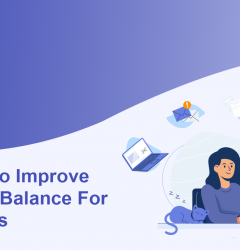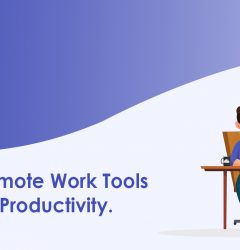21 Jun

According to a survey, 33% of workers quit their jobs because they are unhappy and prefer to take on new challenges.
We’ve all had weekday setbacks at work at this point. Employees aren’t motivated by their work since what we feel as job discontentment has become so common in workplaces.
Despite businesses rebranding themselves as technically proficient, proactive rivals, many people quit their jobs. A fresh approach is required from HR managers and executives to assist staff in discovering meaning in their job. Job enrichment is a tactic that effectively helps fight work stress.
This blog will walk you through the definition of job enrichment, the best practices to put into practice, and a few extra pointers that will help you promote more workplace engagement.
Table of Contents
What is job enrichment?
Job enrichment definition: “The goal of the job enrichment strategy is to boost employee happiness by giving them more power and responsibility while still allowing them to utilize their strengths to the fullest.”
In other words, job enrichment refers to the chance provided to employees to explore their skills when a challenging assignment is assigned to them. Job enrichment is a vertical reformation of moral excellence in which employees are given greater power, freedom, and control to carry out a certain set of tasks.
This idea differs from the idea of job enlargement, which takes into account horizontal reformation, where tasks are added one at a time, but the difficulty level stays the same.
Job Enrichment Examples
Here are some examples you can use as inspiration as you put your job enrichment program into action:
Suppose you hired a writer who shows interest and a desire to get their hands dirty within their first few months. Let’s start with the marketing division. You would ideally give them fresh content based on briefs provided by the content manager to match that enthusiasm. When finished, their content would be edited by an editor and examined for optimization by the SEO manager.
Your new talent is still performing their job of writing articles from the perspective of job enrichment. However, they can now write their briefs, write the content, optimize it for SEO, review it, and publish it on schedule instead of simply writing. They are now in charge of the entire procedure, as you can see.
As a means of energizing employees’ work, HRM Practice recommends job rotation. Let’s say that every task performed on the production floor or in the legal research division is largely routine. Employees are required to learn or use new skills when they are cycled into each other’s positions in the same or a similar department. The disadvantage is that some people may not be able to succeed in their primary talents if they study multiple professions.
Task identity is another element of job enrichment that lets employees understand the results of their job. People would feel quite proud of themselves after stating, “I built that” or “I made that,” when they look at a finished work. Products and projects are frequently split up in modern business. One way to provide a team task identity is to have them manage the entire project.
Another strategy to improve your team’s productivity is to highlight task importance. They can get over the idea that they are nothing more than cubicle drones by just being shown how their job benefits the company’s performance. Giving employees more freedom in their work is another way to increase employee satisfaction. A traditional yet powerful method of enrichment is to give your staff positive comments and let them know how well they’re doing.
Characteristics of Job enrichment
The characteristics of Job enrichment are:-
1. Relationship with clients
A person whose job involves serving a client or customer directly has a more fulfilling experience. Customers could either be outsiders, such as mechanics interacting with car owners, or insiders, such as computer operators working for other departments.
2. Direct Feedback
Through job enrichment, employees should be able to see the results they are achieving immediately. Performance evaluations can be incorporated into jobs or handled by supervisors.
3. Self Scheduling
It would be possible for an employee to set his schedule as part of job enrichment. Scheduling your time according to what assignments you need to complete is an example of self-scheduling. It is easier for employees who perform creative work or those who perform routine tasks to schedule their assignments.
4. Resource Management
Employees will be able to control their expenses and resources under job enrichment. Among other things, employees are responsible for ordering supplies necessary for their jobs.
5. Regulatory authority for direct communications
A worker with an enriched job has direct contact with people who use their products, for example, a quality assurance manager who deals with customer complaints.
6. Taking responsibility
When an employee has an enriched job, he or she is held accountable for the outcomes. The reason for this is that he or she is praised for excellent work and criticized for bad effort.
7. Unique Aspects
An enriched job will have certain unique aspects or features, such as a quality controller visiting a supplier.
8. New Learning
An enriched job allows its user to feel as if he is intellectually growing.
Advantages of Job Enrichment
You can question if job enrichment is beneficial for an employer. After all, adding new tasks for even each employee, let alone a whole department seems to be more work. However, if you use job enrichment, your employee will be able to perform at their best all the time.
Here are a few additional advantages to consider:
1. Enhanced employee experience
You could offer ‘a difficult work environment’ to recruit fresh talent, but are you able to deliver on this experience? Create job enrichment chances for your employees so they may continue learning instead of following the same daily routines in order to uphold your end of the contract.
2. Reduced absenteeism among employees
Organizations claim that job enrichment programs have reduced employee absenteeism, despite the lack of solid data to support this. They were encouraged to do better because it gave them a sense of forwarding momentum.
3. Reduced turnover
The ones that are engaged and satisfied at work are the ones who will stick around. In a downsizing company’s high-stress environment, job enrichment boosts loyalty.
Provide your staff with a variety of meaningful things to complete if you want them to be productive rather than just browsing job vacancies when they clock in. Instead of merely working for a salary, they will feel like they are contributing to something bigger.
4. Increased motivation
People are known to perform better in collaborative work environments. They will be inspired to work harder and accept difficult or unpopular duties if you give them more responsibility and give them the chance to collaborate in groups.
5. Developing potential
It can be highly beneficial for both your organization and your employees if you encourage them to use their hidden skills. They have such a great opportunity to progress beyond their regular duties and promote to a role they are seeking. On the other side, you will be surprised by the number of ways your employees help your company achieve its target.
Disadvantages of Job Enrichment
While job enrichment is important for your employee’s career growth, it’s also important to consider its disadvantages. The following are some disadvantages of job enrichment that you should think about before implementing it in your organization:
1. Not as much participation as expected
Assuming that every employee wants to look into new work practices is a bad idea.
The impacts of job enrichment will have a negative impact on certain people’s productivity, and some people may feel unlikely to participate.
Be patient with workers who simply want to do their part of the job, get their paycheck, and go home. They will perform worse as a result of an initiative like this, which is easily going to backfire.
2. An increase in work hours
Adding more responsibilities to your workers’ existing workflow may quickly become a stressful task. Rather than being motivated to broaden their skill sets, they will be more concerned with how to manage their job while taking on additional responsibilities.
Before implementing any initiative, ensure that your employees can handle higher responsibilities within a 40-hour workweek or whatever their schedule may be.
3. Managerial micromanagement
Employees and managers should work collaboratively while taking on new responsibilities. As a result, managers frequently need to supervise employees more closely since they can only work with their staff. This could also result in constant micromanagement, which may not be in your employees’ interests.
Job Enrichment Techniques
We will discuss some job enrichment techniques in this section. All of these techniques work to expand roles, increase autonomy, and increase the range of skills used.
1. Forming natural work groups
Gathering similar jobs together is how natural work units are formed. This promotes ownership of the activities and enables the employee to witness the effects of their efforts, increasing job identity, perceived task importance, and ownership.
2. Combining the Tasks
Divided tasks can be combined to provide larger, more satisfying positions. A manufacturer of laboratory hotplates, Corning Glass Works, mentions that to enable each operator to fully assemble, check, and ship a hotplate, many activities were combined.
Because each assembler could relate to a finished product and evaluate it independently, there was an increase in job significance, autonomy, and feedback. As a consequence, production increased by 84%, controlled rejections decreased from 23 to less than 1%, and absenteeism decreased from 8 to less than 1%.
3. Quality circles
Employee groups known as quality circles or Kaizen groups often get together to discuss methods to solve issues and boost productivity in their workplaces. These small groups promote task identity and autonomy while increasing participative management.
4. Task forces
A unit formed to operate on a single clearly defined task or activity is known as a task team, task force, or task group. It was initially developed by the US Navy and is now utilized in professional settings. A team of workers collaborates to suggest improvements for particular business activity, much like the quality circle, and is frequently guided by a manager.
5. Suggestive program
Employee Suggestion Programs (ESP) allow staff members to make recommendations that enhance their performance and the quality of their work in accordance with quality circles. Normally, HR is in charge of the ESP. Employees who have successful ideas that save money or generate income may occasionally get financial bonuses.
6. Use Feedback Wisely
Ensure that everyone on your team is aware of their performance. But explore the ways of making it feasible for them to assess and keep track of their own performance. The more authority they have over this, the more valuable their careers will be as they build their own problem-solving, initiative, and decision-making skills. If needed, you can still provide immediate feedback.
Numerous options for growth are offered through job enrichment. People will probably feel more personally accountable for their jobs if they can participate in how their work is completed.
Limitations of Job Enrichment
When job enrichment became popular as a motivational strategy in the 1970s, both academics and practitioners were quick to criticize it. They questioned if job enrichment was beneficial. Job enrichment is generally subject to the same criticisms as the two-factor theory of motivation.
Apart from the difficulties in implementing job enrichment into reality, it does not deliver the expected outcomes. Firstly, it must be determined whether employees actually want the kind of changes in work content that are being implemented as part of the job enrichment program. According to many studies, relatively few employees are unhappy with their current positions, and a very small percentage of them want their employment responsibilities changed.
This issue is more serious in India since employees there demand better salaries and job stability. Second, only unskilled and semi-skilled people can really enrich their jobs. Highly skilled managers and professional’s jobs come in a variety of degrees and provide a lot of challenges and opportunities for success.
As a result, there isn’t much room for implementing job enrichment. They can be improved by using contemporary management strategies, such as management by objectives, participative management, authority delegation, status systems, etc., rather than the conventional ways.
Apart from these limitations, there are certain issues with implementing job enrichment in practice, which result in insufficient payouts. First, it appears that top managers and personnel experts have a tendency to apply their own scale of challenge and accomplishment values to other people’s personalities.
Workers are more likely to reject this than accept it. Second, job enrichment is often imposed on workers rather than implemented with their consent. Many groups that have attempted job enrichment have experienced similar issues.
Despite these limitations, job enrichment is a helpful, motivating approach; however, management must utilize it selectively and with proper consideration for the complex human and situational aspects.
There are a number of limitations to job enrichment, including the following:
- Workplace issues are hardly ever identified until roles are redesigned.
- In several situations, the work itself is not actually damaged.
- Even if the task itself is significantly altered, predicted gains are reduced or reversed due to unpredictable impacts on the surrounding work system.
- Work design projects are rarely and thoroughly examined.
- Line managers, consulting staff, and union officials are still unable to receive adequate training in the concept and strategy of work redesign.
- Traditional bureaucratic methods hamper work redesign.
Job Enrichment vs. Job Enlargement
Job enlargement is the expansion of job obligations by broadening the scope of job responsibilities. Unlike vertical loading, which increases the degree of control, job enlargement simply adds responsibilities to the job without necessarily enhancing autonomy or control.
Job enlargement allows a person to achieve more, participate in a broader range of activities, expand their skill set, and improve their earning potential.
A good example is an office secretary who will now also greet clients in the office. This provides her a welcome break from her regular duties because she enjoys making people feel more comfortable and chatting with new people. This will boost her motivation.
The impacts of job enlargement fade with time. At some time, the office secretary begins to view clients as an annoying distraction that keeps her from finishing her work, with the impact fading as the novelty wears off.
Job creep refers to the continuous growth of job enlargement. This occurs when an employee is assigned a variety of tasks, resulting in an unmanageable workload.
When we consider job enrichment vs. job enlargement, we can see that job enlargement is a specific method of enriching jobs. An employee can have a more meaningful and motivating work experience by adding duties and increasing the job load.
Wrapping It Up
Many organizations are noticing the link between an employee’s performance and their strong connection to their job. If you want to establish a workplace where your employees feel valued and motivated to give their all, job enrichment is the way to go.
Regardless of your budget, it is practical, affordable, and simple to execute. This concludes us with all you need to know about job enrichment.
Frequently Asked Questions (FAQs)
1. What is the importance of job enrichment?
Job enrichment expands your work setting and allows you to gain new talents. This leads to more challenging and fascinating work, as well as wider choice, difficulty, and depth in your everyday routine. Job enrichment provides you with additional flexibility, independence, and responsibility.
2. How can job enrichment motivate employees?
Job enrichment seeks to offer employees more responsibility by expanding the variety and complexity of duties assigned to them and granting them the appropriate power. It motivates employees by allowing them to fully utilize their abilities.












Himani